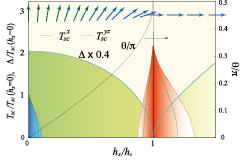Superconductivity near a Transverse Saturation Field in URhGe
Tsunetsugu Group
Ferromagnetic superconductivity in uranium-based heavy-fermion compounds has attracted much attention in condensed matter physics in the last decade. UGe2, URhGe, UIr, and UCoGe show unconventional superconductivity within their ferromagnetic phases. Nonunitary superconductivity is believed to appear in these compounds and their pairing mechanism and symmetry as well as novel self-induced vortex states are central issues to be clarified in the modern theory of unconventional superconductors. Among these ferromagnetic superconductors, two isomorphic compounds, UTGe (T = Rh, Co), exhibit superconductivity at ambient pressure within their ferromagnetic state and have a similar Ising-type anisotropy of magnetization. Spontaneous moment appears parallel to the c axis, and its magnetization curve exhibits meta-magnetic behavior with a notable mass enhancement when magnetic field H is applied to the b direction. This meta-magnetism is particularly prominent in URhGe and the moment gradually tilts with field and finally aligns parallel to H at hs = 12 T. Superconductivity appears below the transition temperature Tsc = 0.24 K for H = 0, and Tsc decreases with H and disappears at 2 T for H // b. Interestingly, superconductivity reappears above 8 T and shows the highest Tsc = 0.42 K at 12 T. The mechanism of this novel re-entrant superconductivity has not been fully clarified until now.

Fig. 1. Temperature - magnetic field (hx) phase diagram. P-wave superconducting transition temperature for the polar state (Txsc) and that for the ABM state (Tyzsc) are shown. The amplitude of the gap ∆ in the magnetic excitations and the tilting angle θ of the ferromagnetic moments measured from the zero-field direction are also plotted. The transition temperatures are scaled by the value at hx = 0, where Txsc = Tyzsc. Arrows depict the change in direction of the ferromagnetic moment with magnetic field.
In this project, we propose a mechanism of the re-entrant superconductivity and analyze magnetic-field dependence of the spin-components of the superconducting order parameter. We point out that there are soft magnetic excitations near the transverse-saturation field hs in these anisotropic systems as similar to the case in the transverse Ising system, and clarify how these soft excitations couple with itinerant electrons. We develop a weak-coupling theory of p-wave superconductivity in the presence of both ferromagnetism and magnetic field.
Figure 1 shows our result of temperature-magnetic field (hx) phase diagram. Here, hx represents the magnetic field strength in b direction. The superconducting transition temperatures for the polar state (Txsc) and that for the ABM state (Tyzsc) are depicted. The amplitude of the gap ∆ in the magnetic excitations and the tilting angle θ are also plotted in Fig. 1. In the low-field region, Tsc is suppressed as hx increases and disappears due to orbital pair-breaking effects. In the high-field region near the saturation field hs, another superconducting phase appears and the transition temperature reaches a maximum at the saturation field and then is suppressed. As we commented above, the magnetic-excitation gap ∆ gradually decreases with approaching hs and vanishes at hs. At the saturation field, the energy dispersion of the magnetic excitations is linear in the momentum, which represents the system is at a critical point. Above hs, the excitations acquire a finite gap again and the gap increases linearly in hx at higher fields.
The strong enhancement in the transition temperature near the saturation field arises from quantum critical fluctuations there and the nature of the fluctuations strongly restricts symmetry of the Cooper pairs. Analyzing the fluctuations near the saturation field, we find that the exchanging magnetic fluctuations between two electrons (Cooper pair) leads to electron spin flipping. Combining the fact that the Zeeman effects favor the equal-spin pairs and now the spin is not conserved in the presence of the transverse field, the dominant superconducting order parameter is a linear combination of the two equal-spin pairing states. This state is completely different from that in the low field superconducting state, where only one of the equal-spin pairing states is realized due to the strong Zeeman effects by the ferromagnetism.
The phase diagram we have determined is qualitatively consistent with that in URhGe. Experimental determination of the superconducting order parameters near the saturation field is an interesting subject in the future progress for understanding the ferromagnetic superconductivity in URhGe. For more quantitative analyses, it is important to include longitudinal spin fluctuations, which have been observed in UCoGe. Such longitudinal fluctuations would play an important role for realizing meta-magnetic behaviors near the saturation field in URhGe.
References
- [1] K. Hattori and H. Tsunetsugu, Phys. Rev. B 87, 064501 (2013).
